Driving away from Mytvn on the N1 ring road, we were told to make a small additional loop. This not because of scenery, but by doing so, we would by-pass the only piece of toll road on Iceland, which is actually a toll tunnel. And yes, an expensive one! Besides that, we were unable to register for this toll online, because our number plate was not recognized in the system. And the only way to make the payment, yes, is online.
The city of Akureyri is located at the end of a fjord and is the biggest harbor town in the north of Iceland. When we almost finished the loop, we could see the town in the near distance. What surprised us right away, was the 3 very big cruise ships moored at the docks of the harbor.
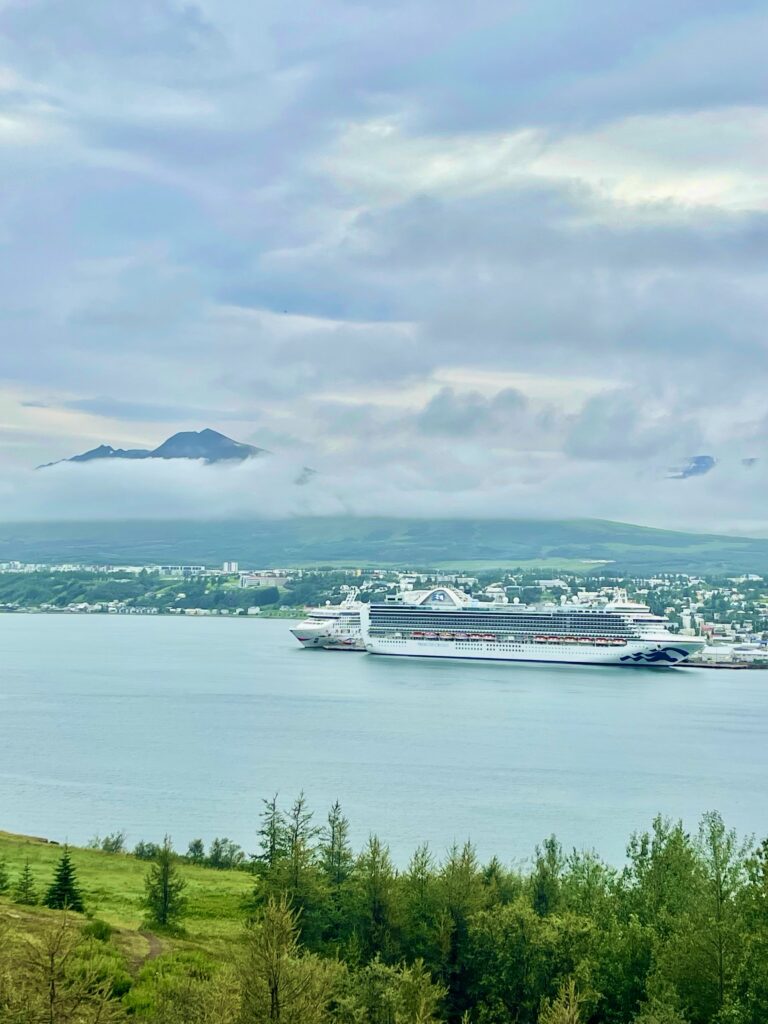
We now understood where all these big tour busses came from, we met them when driving towards Akureyri. Half way towards the town, we stopped at a very large waterfall. It was crowded with people, full parking lot and many tour buses. It was then that I wondered, where do all these people come from. I could image only so many hotels in the area. And yes, Akureyri is one of the bigger cruise ship destinations in Iceland. Passengers jump off the boat and do a walk to the small old town of Akureyri and/or do day tours with a bus to some of the interesting sites in the area. (Similar to all cruise ship ports).

Before leaving our last campsite, I contacted our Icelandic friend, Jon (the guy who located the new tire for us), about where I should go to find the tire. He was so friendly to meet us at the entrance of town and guided us to the tire shop. We met at a gasstation, where he and his wife (Christi), greeted us and drove us straight to the tire shop. He did the talking and explaining to the manager (who happened to be the brother of an employee of his son’s trucking company), so we knew we would be taken well care off.
Indeed, they only had one tire for us and yes, it was the only one available in Iceland. Only thing was that the tire (although new), was made in 2004, meaning that the rubber could be dried out a bit. We had no choice and I wanted to continue traveling with two spare tires (the other one which I couldn’t pump up, was pumped up successfully in the tire shop, as they obviously had the right tools to do this), so I bought the tire. They were nice enough to give me a big discount, due to the age of the tire. For a spare one, I figured this should work well enough. The guys in the tire shop were extremely helpful. Some employees came from Latvia and one even from Jordan and they were all happily impressed that the truck had visited their countries as well.

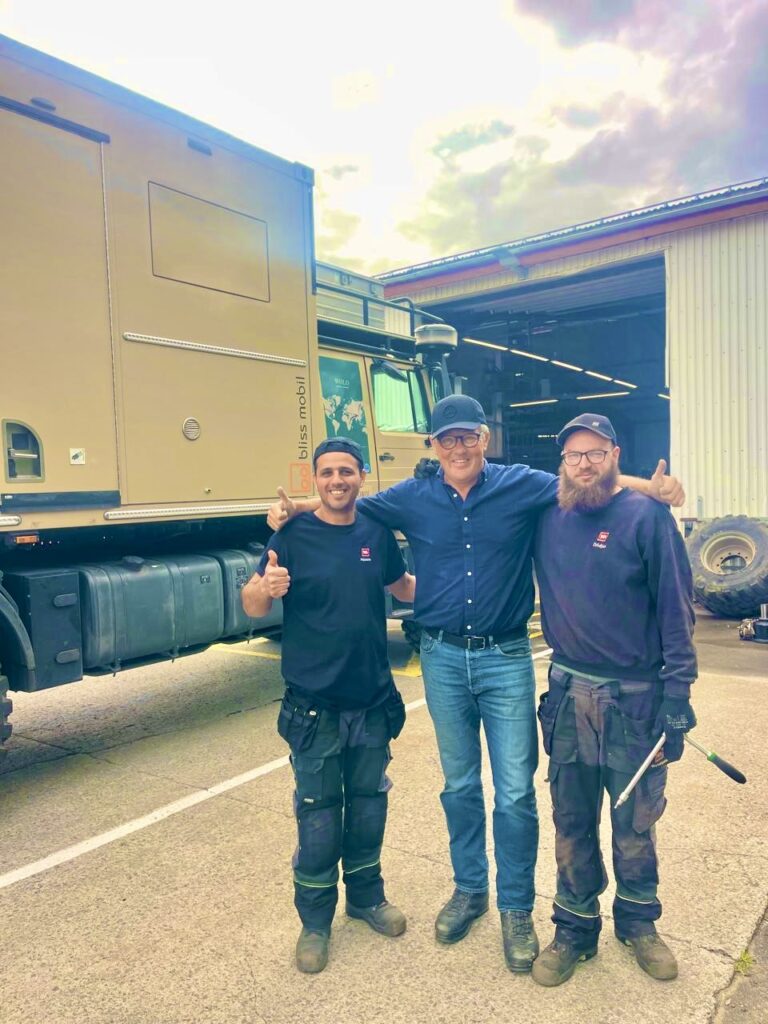
Jon and his wife came back, once we were done at the tire shop. I told him I was happy that I had my spare tire issue solved, however, I was not able to place back the tire inflation valve, because the tube‘s thread was damaged. He said that he could help me with that as well. His son has a work shop and most probably we could fix it there.
Well, his son indeed has a work shop! A huge one, with lots of tools and parts (and even a truck cabin converted into a bar!). His son has a trucking company with a number of big Scania trucks. Besides that, he races with buggies, so the workshop is a full mechanic shop. However, what we needed, wasn’t there and my issue could therefor not be fixed here. But Jon had another option. In town was a speciality shop, where for almost 100% sure, they would have spare parts or otherwise they could make them. Especially, since Iceland is the country, where tire inflation and deflation is part of your daily driving skills. Due to the fact that there are so many gravel, pebble and rock roads, tires need to be inflated and deflated regularly, when driving these roads to avoid flat tires. For that reason, many off-road cars and trucks have exterior (automatic) inflation systems, which saves a lot of time. However, due to the terrain these system can get damaged. There are also a lot of different systems for different type of vehicles.

For that reason, there is this shop in town where they have it all and if they don’t have it, they can make parts of the spot! And yes, they were great, fixing the tube and making some additional spare ones for us to keep for just in case. Ready while we were waiting! What a great service!
Jon was not finished helping us! He asked if we had a place to camp that night, since he owns a big plot of land with a forest, where he has his caravan parked and where he plans to build his new house. So we drove to this spot and it was excellent. We parked the truck and had some coffee inside. Jon – as a pilot – is close to his retirement. And from the beginning I was wondering why he was so interested in the details of our truck. Visiting his son’s workshop, he actually showed me the reason. A big brand new 6×6 Scania truck, with a “naked” chassis was parked in the large workshop. He has plans to build his own camper truck! He even visited the Bliss booth during a camper show in Germany, so he was fully aware of the existence of our kind of camper trucks.
I was happy to show him and explain him everything about it.

We invited him and his wife to go out for dinner in town, which was very nice. After dinner, they drove us around to show the town and its surroundings. Akureyri is a pleasant town, with a nice old part, a small city centre with cafes and shops and well laid out sub-communities. Opposite the town (other side of the fjord), we found a small warm water bath, which was accidentally created, when they were drilling the tunnel. They hit a natural unexposed hot water well, which started to flood the tunnel. That water was then diverted to next to the tunnel, towards the fjord. But not before accumulating in a small pond, which overlooks the fjord towards the town. Locales and visitors (who know about it), like to enjoy this small warm water retreat.

We left Akureyri the next morning, but not before fueling up, getting some nice fresh bread from the first real bakery we found in Iceland and stocking up at the supermarket. Heading north we drove into the large peninsula of Trollaskagi. We followed the road around the peninsula and made a stop at a nice small fishing town called Siglufjordur. This town has an interesting history with regards to Herring fishing. An old Herring processing plant (to make fish meal) was restored and turned into a museum. It’s hard to imagine the enormous activity with hundreds of fishing boats, herring girls (the girls who cleaned the herring) and tons and tons of fish off loaded on the docks of this now cute, little town with its colorful houses, not too long ago.


Driving first a short while on the ring road, we turned off on a so called F road. These are rough dirt/gravel roads, accessible for 4×4 vehicles only. These roads are not frequently used and closed in the wintertime. This road would bring us to the interior and away from civilization. It was a road hardly used by other tourists.
Before the real hard part started, we passed a sign saying that the road would be closed for a certain time that day. We still continued driving and indeed, the road was blocked because of a rally with tuned up old cars. We lost about an our before the road was open again, but we used to time to have some chats with the mechanics and family members of the boys who were racing. It was actually very nice to see the cars racing over the bumpy rocky road, where some lost parts of the cars. A though ride!


After the fancy Search and Rescue vehicle passed as last vehicle, the road was reopened and we could start our journey into the real wilderness of Iceland. We lowered the tire pressure, engaged 4×4 and checked the map again for our route.
Indeed the F road we took was challenging. Big stones, bolders, uneven, narrow and lots of bends, but no traffic all! We noticed another interesting sign, which was mounted on a barrier. It said that “ when you pass this barrier (if utilized, it closes one half of the road), and you encounter any problems, that any assistance maybe very expensive”. Distances are far and areas are sparsely populated, so in case of being stuck in the snow, a river, or mud slides, recovery can then be very expensive. Also rental companies don’t allow their cars not to be used on these roads.


With that in mind, we accepted the challenge. It was not winter and we do have two spare tires. From asphalt to a graded gravel road and then to an ungraded road. We left the last farm with green pasture land behind us. We noticed that farms sometimes look like vehicle scrap yards. Farmers just don’t get rid of their broken down vehicles or machines. They park them somewhere away from the farmhouse. In case they need a spare part or something else, they can take it from the wreck. Life is expensive in Iceland, even the removal and disposal of old broken down vehicles. Besides that, they still have value for many purposes. Some farmers became a little more creative when noticing the interest of tourists, passing by their farms. They made small museums of old cars, trucks and tractors. And always with a coffee corner!! You find these little museums all over Iceland, including the little more informative and professional museums about living in the old days (fishing, agriculture ect).



From now on we left the “inhabited” part of Iceland and drove into the interior, the Highlands. It’s like a big dessert plateau with dormant volcanos, rivers and streams, tundras, and besides the F-roads, some smaller tracks. The F-roads and the tracks are the only spots you can drive on. Off-road driving is strictly forbidden and hefty fines are in place when the police catches you when doing it! Tracks to the virgin landscape of tundras, lava sand fields, are like un-repairable scars and destroy the very uniqueness of this millions of years old environment. We have learned that it is very important to make sure that no driving besides the roads or tracks is absolutely not done!


To get the most out of our off-road experience and get the best “alone in the wilderness feeling”, we went from the F road to the tracks, which brought us closer to the tundra, which originates at the foot of the Hofsjokull ice cap, the 3rd largest in Iceland (830km2). Melt water from the glaciers of the ice cap flows down into hundreds of little streams, making the area around the ice cap look like one big delta, with lush summer vegetation and many colorful little flowers. Lots of migrating birds (like the Pink foot goose) stop here to nest, feed their young and fly south again when the season changes.

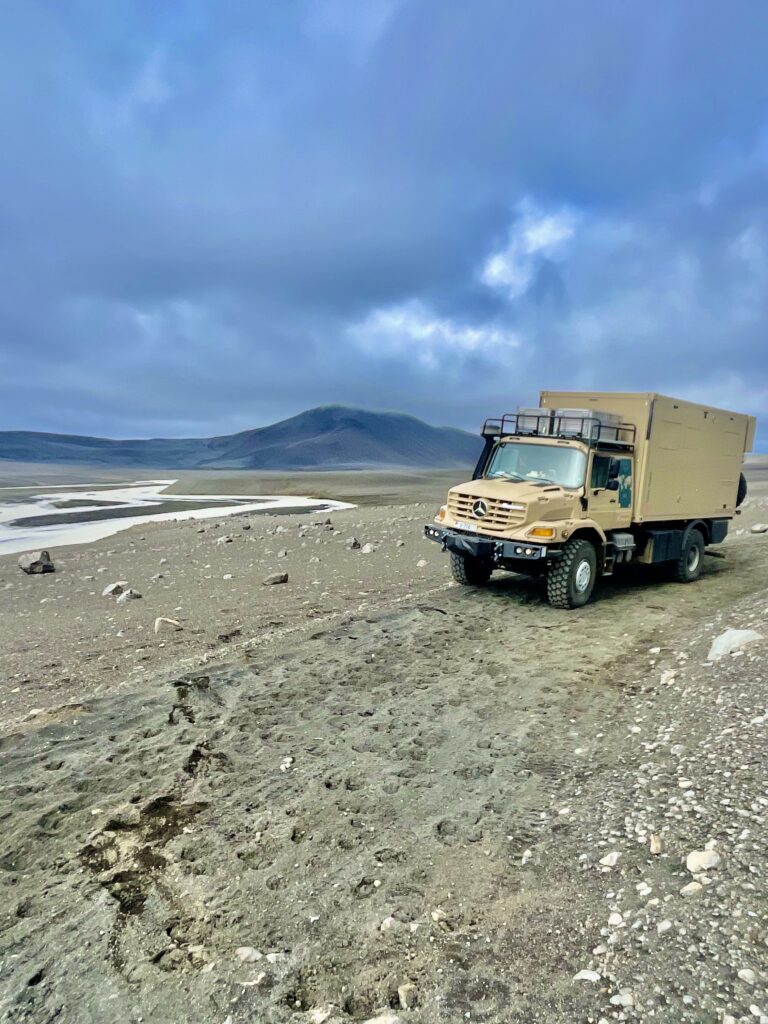
On a clear day, it’s a magical sight, that huge mountain (which is the largest active central volcano in Iceland), with the white blanket of ice and snow. Along these lonely tracks, you see a different Iceland and realize how sparsely populated Iceland is.

The tracks navigate through small and larger rivers, which are no problem to handle for the Zetros and add to the feeling of remoteness and adventure.

Near one of our camp spots, we made our first attempt to reach the big glacier we are looking at from our truck. I estimated an hour walk to do that, but after crossing the first view hills and streams, we came upon a huge delta full of rivers, streams, mud and soggy grassland. With all our zigzag walking we didn’t get any closer. Here and there goose were alarmed by our presence and flew away under loud protest.


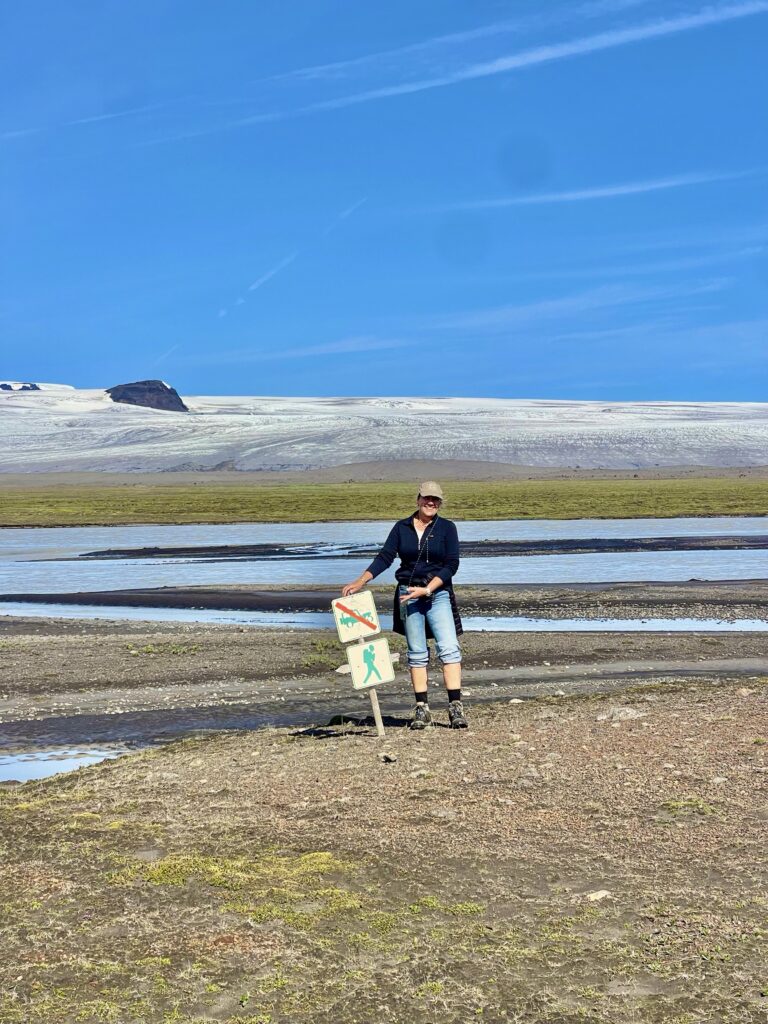
In the old days, the Highlands of Iceland were a wasteland, where people who didn’t fit into Iceland’s society (like criminals), were sent to spend a number of years or even the rest of their lives. Others just went voluntary into the Highlands to live a solitary life. Over the years, archeologists have discovered the remains of small huts or houses, where these so called “outlaws” lived. In houses constructed out of rocks, mud and turf, they survived a harsh climate with dark, long and cold winters. They lived of what the land and rivers had to offer. They were outlaws and discarded people in their time, but now have become part of the many legends Iceland is rich of and give a human aspect to the Highlands. Iceland did not have any prison in those days, so sent their criminals into the harsh interior to live as an outlaw.


Occasionally we encountered another vehicle, often locals or foreign travelers with 4×4 jeeps, but most of the time it was us between the many lava rock fields, volcanic sand deserts and the hills. Words can’t do justice to the beauty of the sceneries presented to us, and the big front window of our truck cabin is like a big tv screen, where a nature movie is running the whole day.


The world feels endless and we wish the tracks would never end….but unfortunately, after a couple of days, we first reached a small shelter camp with some natural hot springs. At first sight we wanted to stop and jump in, but we were still in our bubble of solidarity. A number of cars were already parked there and the springs were occupied. It also meant we were now closer to a more accessible road.

Driving this more accessible road, doesn’t mean heavy traffic right away. The main road we reached when coming from the last track, was still a gravel road. A road crossing from south to north through the Highlands. But we didn’t go back north, we wanted to go deeper into the highlands. A shelter and ranger post called Nyidalur at the beginning of the next F road (F910), was a point of entry into the next chapter of our Highlands journey. Several warning signs about how bad the road was, with deep river crossings and 4×4 only made us already enthusiastic.

From the F910 we took a track, which runs even closer along the largest ice cap of Iceland (Vatnajokull). We went in and soon we already encountered a very rough surface of big rocks, sharp corners and dangerous lava stones. Low speed and very low tyre pressure were the key again for safe passage. After a tiring tour, we reached a beautifully well-maintained shelter (used by hiking groups and sheep shepherds when they need shelter when they bring the sheep together at the end of the summer). The track continued but now with an even tougher warning “access only for Super Jeeps”. These are the 4×4 jeeps with the huge tires, which have far less problems to drive over the big rocks and lava stones than any other vehicle. But of course, we still tried, but only for a short while. Very soon it became really difficult to navigate. And yes, then had to turn around and go all the way back to the F910.




”Luckily” the F910, became also a bit tough after a while, so it reduces the change to encounter the many little rental cars and 2×4 vehicles we saw on other roads. An empty parking lot with a view on a nice waterfall became our night camp on the second part of our Highland adventure.
When volcanos erupt and lava flows out over the surrounding area, this is combined with ass fall and rocks a lava drops falling down from the sky. After the top of a volcano gets blown away by the pressure of the eruption, large parts of the area will transform in an instance. If the land around a volcano was already not useable, it will be now it will for a very long time. Many square kilometers of land are covered by solidified lava and big rocks. Removing them, if possible at all, will take years and cost a fortune. Although lava contains a lot of usable minerals, the land can not be used for agriculture. In case roads and tracks were covered with lava, these roads were adjusted to the path of the solidified lava streams. New tracks made going around it.





A walking trail made by park rangers along the track, makes you really realize the magnitude of a lave stream. Now solidified, but once a burning river of super hot (up to 1200 degrees Celsius) molted rock, you can walk over it and see the “beauty” of it, with the most strange forms. Sometimes beautiful pieces of flat wave-like surfaces can be seen, other times lava pieces look more like monstrous tentacle creatures. The older lava fields have become home to particular species of moss, which thrive on the minerals contained in the lava. Bigger plants and scrub species also find their way into the lava fields and over a period of hundreds of years, the lava fields will be transformed into new lush green areas.



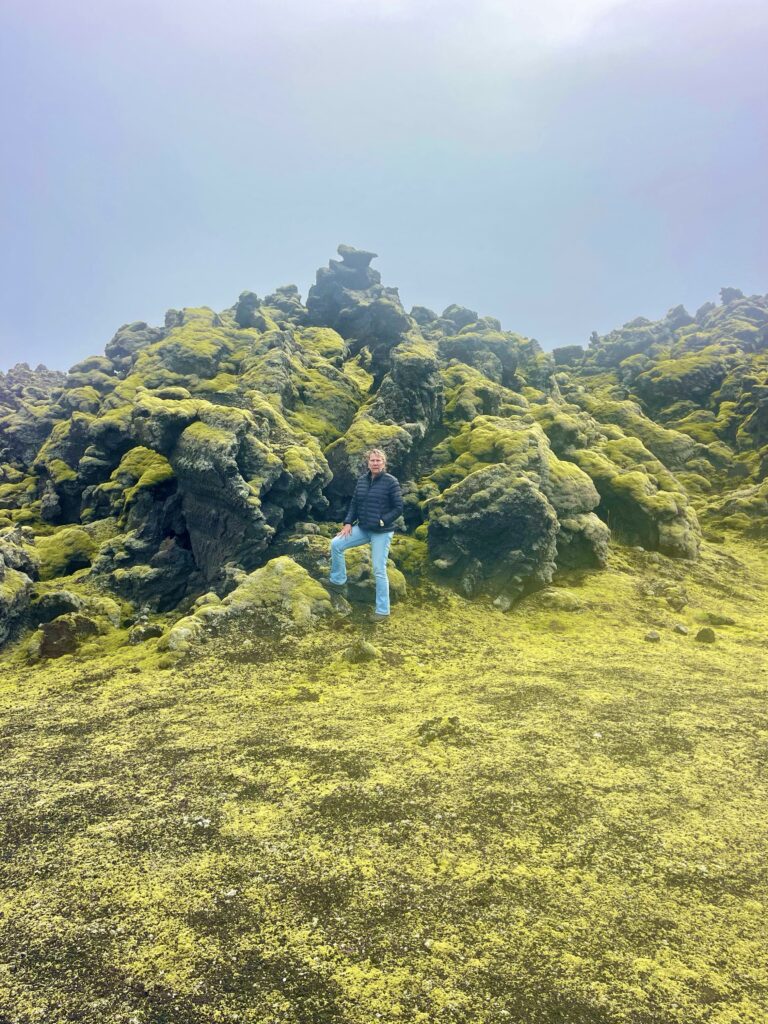
That Iceland is still “alive” means that close under the surface Iceland is an island, that is changing is geographical and geological look. Under the surface many processes are active like we saw at the mud-volcanos. Driving over a huge plain of ash, were the wind blows fast, stirring up large columns of dust and where lonely hikers, wrestling themselves with heavy backpacks, through the elements, we thought that in a distance we saw a fata morgana. A patch of green, in the middle of the black sand plain, like an oasis.






A cold water well bubbles up at several spots, creating a lake and a river flowing into the desert. Rich mineral water, which allows many plants, mosses and flowers to grow, turning this small area into a small garden of Eden, within a black and grey rough world. A popular stop over for the Pink footed goose and other birds. From hot mud to chrystal clean cold water, mother earth keeps surprising us.



Our lonely ride over the F910, which provided us with beautiful sceneries, and peaceful camp spots, was almost coming to an end. A large super jeep of the Search and Rescue service of Iceland passed us, most probably looking for the young hiker who knocked on our door on this lonely road.
He knocked on our door that day, at exactly 7 o’clock in the morning. It had been a terrible stormy night, the truck was shaking and there was a lot of noise from the wind. We slept badly that night and so this young hiker did as well. His tent was blown into pieces and he asked us if we were going to town and if so, if he could get a ride. Unfortunately we were not going to a nearby town but we offered him any other assistance (like we were going to a nearby camp), but he refused that and only wanted to go to a nearby town, to have his tent fixed or replaced. He moved on and we felt very sorry for the guy. We had hope that maybe another vehicle would pass in the other direction and give him ride. At the end it was the Search and Rescue vehicle we saw passing us, so we trust they have helped him out.
From black lava to sand and dust, we entered suddenly in an area white small stones, like if nature was tired of all the darkness it had created. The forces below the surface of the Earth can have unpredictable results. I can imagine that geology can be an interesting subject to study.
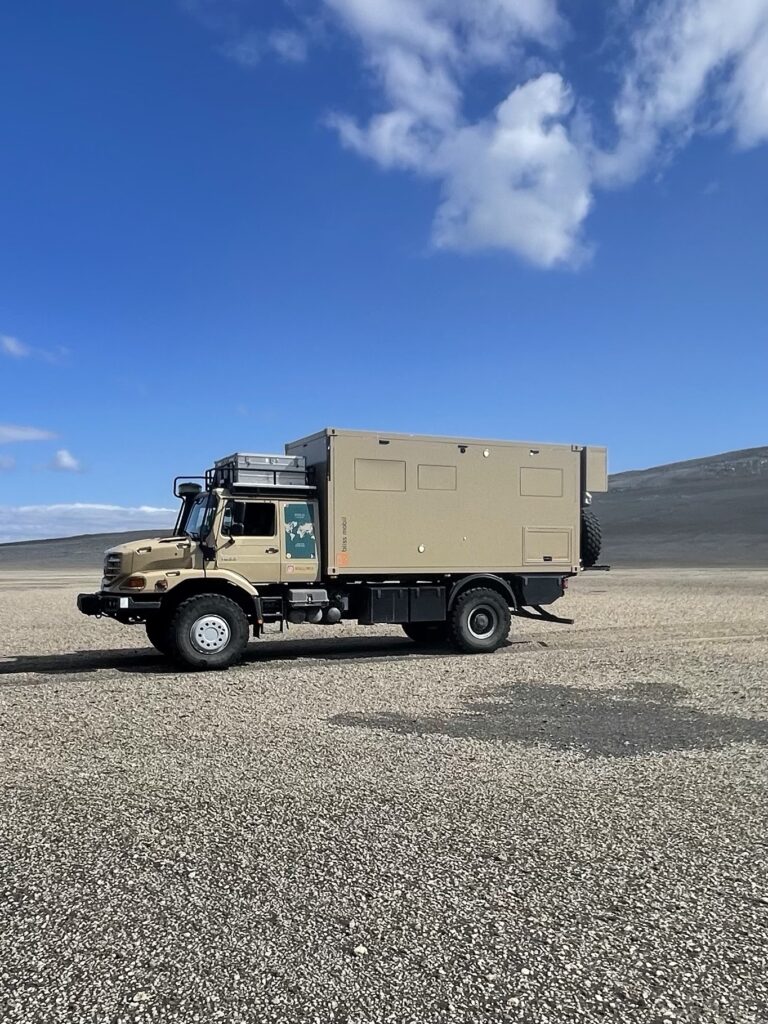
In the deep center of the highlands, there is Askia. An old volcano with inside its crater, a small lake with hot sulfur water, which is bright turquoise. One of the more famous spots to visit, but remote and a difficult road (hence not that many visitors). The crater is within an even bigger crater, which became a large lake. Standing and walking on the edges of the volcano rim, its hard to imagine the brutal forces which were at work here. And these forces are now asleep, but in Iceland can be awaken any moment!


On the way to a nearby campsite, we run into Tony (from Belgium) , who we met during our ferry ride to the Faroe Islands. His wife has joined him now and we were happy to see each other. Later that evening we met again at the camp. At that same camp we also run into the black Bliss Zetros (from Switserland), who we had seen some days ago. That evening we all came together in the community room, where you can use the kitchen, eat, drink and meet other people who stay at the camp. So a couple from Belgium, Switserland and Sint Maarten shared their food, drinks and travel stories. Was a great evening to be with a group of like minded travelers. That is what we like so much about this kind of camps. It is on purpose I do not call it a campsite or camping. It is a basic camp in a wild area.



Together with Tony and Annick in their Mercedes Sprinter we drove to the foot of a glacier not far from the camp. It was the first time for us to get so close to a glacier. Remnants of the last Ice Age, these huge packs of ice have been there for thousands or maybe even millions of years. Arriving at the foot of the glaciers, large volumes of water flow down from the glacier. The glaciers are melting and slowly retreating until the time comes that they will be gone. The top of this glacier was covered with stones, sand and ashes. Storms and volcanic ash over time can change the white surface of the glaciers into “dirty looking” fields of ice and frozen snow. Where a white surface will reflect sunlight a darker surface will not and hence accelerate the melting of the ice. Glaciers are even melting under the top layer and form large ice caves and tunnels.


I had brought a cooler bag so we could bring some pieces of the old ice from the glacier we found……a Gin and Tonic on ice, thousands or millions of years old! In places like Dubai, this is one of these special luxuries, people pay a lot for!


Near the glacier was another camp where we spent the night and had some fun and food in the community room. At camps like these you meet different type of people than on the larger campsites along the main road. Much more adventurous, more relaxed and with a better understanding of nature. You hear great stories, get useful tips and advices and people are helpful towards each other. It’s also here where we see the many different off-road versions people use to travel around Iceland.


From here, we had to say goodbye to Tony and Annick. We both would go north in the same direction and mostly on the same road. But their Sprinter would go faster than our Zetros, so we both could continue our journeys at our own speed.

The area around Askia, the glacier and in between is again beautiful. It surprises me time and time again, how just bare rocks, sand, lava in all different forms, shapes and heights, can present such beauty. Somewhere in the middle of all the rawness a small stream, carrying minerals and nutrients, had become a small garden of Eden, with green grass, purple flowers and soft scrubs. On one side of the stream, a wall of solidified lava had created a natural open cave, which was utilized some few hundred years ago, by one of the earliest and most well known Outlaws of Iceland. It’s here where he made a small house and lived there for a good number of years. Not far from this spot on the other side of the plain, where the stream runs through, a similar situation was found by archeologists. Another couple of outlaws used the lava formations as a shelter, to spend a long period of their lives in solitude.




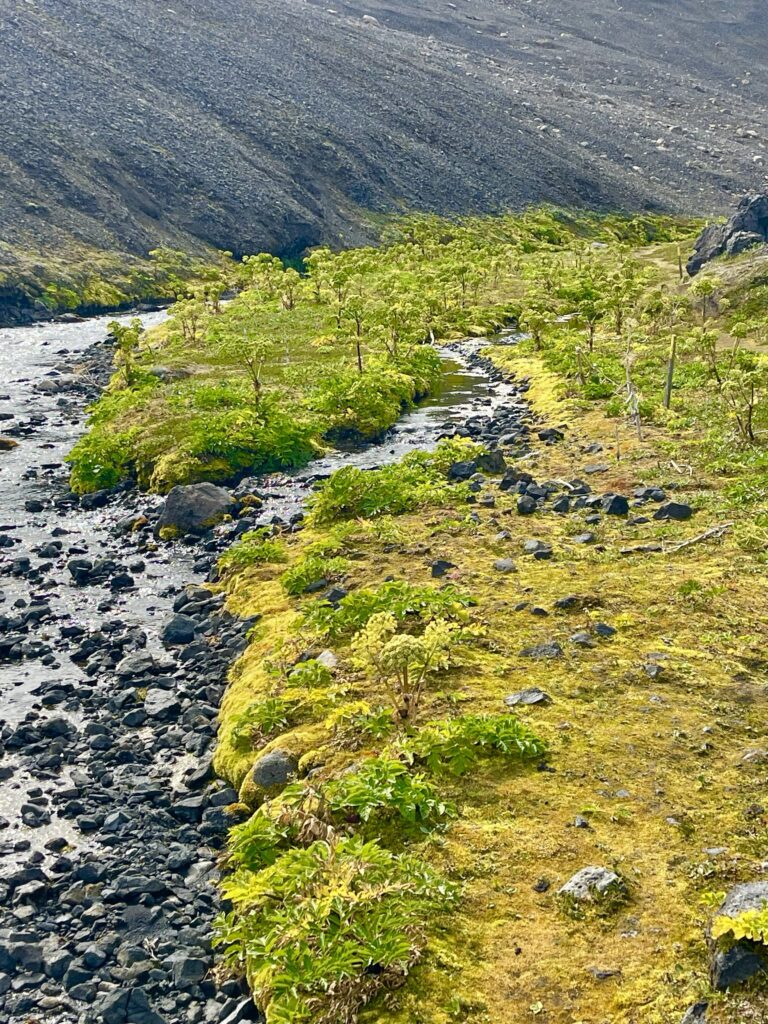


Finding a wild camp spot in the Highlands can be difficult when the road goes through lava fields without small side tracks, but at the end of the day, going back north, a track, which turned out to be a service road for the high tension power lines, provided us with a nice out of sight parking spot. The night however, turned out to be horrible. A strong (sand) storm passed over the highlands and even though we were parked behind a two meter wall of lava rock, the truck was shaking like a boat on the ocean in a storm. Besides that, through the solar panels and other equipment on the roof, the wind was hauling like a pack of wolves. We had little sleep that night…..

But, the storm died down the following morning and the sun started shining again. And like the sandstorm we had in Jordan – and despite the fact that all windows and the door were closed properly – there was volcanic dust everywhere in the unit. So before we headed back to the road, we did some cleaning first. The Highlands didn’t let us go that easily. By the end of the morning we arrived at the ring road. Our first trip through the Highlands came to an end. We had loved every bit of it.
